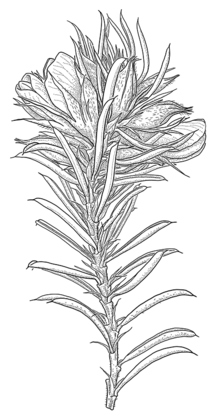Common name: Sutton Bush-pea
Pultenaea praetermissa R.L.Barrett & Albr. APNI* Synonyms: Pultenaea sp. Sutton (C.Burgess s.n., 20 Oct. 1963) APNI*

Description: Erect or spreading shrub, 0.4–1.8 m high, young stems with short, crisped, appressed, matted hairs c. 0.1 mm long.
Alternate, narrowly ±linear, 5.9–7.7 mm long, 0.4–0.7 mm wide, mucronate, margins strongly incurved, usually hiding the upper surface.
Inflorescence a head-like cluster. Calyx 5.3–7.6 mm long, tube densely silky hairy, lobes with long, spreading hairs. Flowers yellow-orange with a small red cresent at the base of the standard, keel deep red at apex. Standard petal 7.8–9.6 mm wide. Ovary with a tuft of long, appressed hairs at base of style.
Ppods ovoid, sparsely hairy at apex.
Flowering: October–December.
Distribution and occurrence: Between Gundaroo, Sutton and near Gininderra on the Southern Tablelands. Gravelly and alluvial soils, in open eucalypt woodland and forest or heath on gentle to steep slopes.
NSW subdivisions: ST
Text by R.L. Barrett, March 2025
Taxon concept: Barrett RL, et al. (2024) Revision of the Pultenaea setulosa species complex (Fabaceae: Mirbelieae) including 14 new species. Australian Systematic Botany 37, SB23014. https://doi.org/10.1071/SB23014
APNI* Provides a link to the Australian Plant Name Index (hosted by the Australian National Botanic Gardens) for comprehensive bibliographic data
***The AVH map option provides a detailed interactive Australia wide distribution map drawn from collections held by all major Australian herbaria participating in the Australian Virtual Herbarium project.
|


